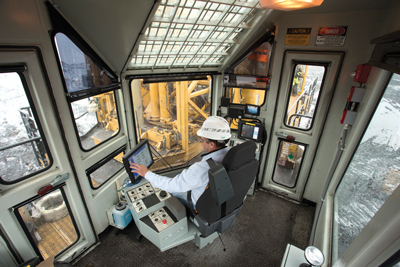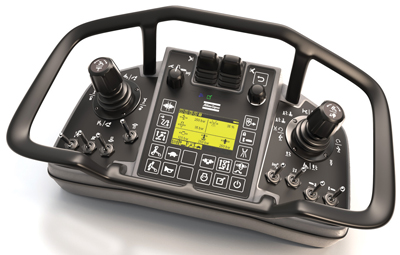 |
| Cat is working on an upgrade to the MD6640 rotary drill rig, shown here—the largest model in its lineup—that will provide state-of-the-art controls, enhanced serviceability and readiness for autonomous operation. |
In a soft equipment market, it takes a firm commitment—and deep resources—to push ahead in a sector that sees unit sales in the hundreds, not thousands.
That’s exactly what Caterpillar is doing in the mining-class surface drill market, according to George R. Regas, commercial strategy manager for Cat’s surface rock drill business.
“Becoming part of Caterpillar was not an easy thing,” Regas told E&MJ during the recent Society for Mining, Metallurgy and Exploration (SME) Annual Meeting and Exhibit in Denver, Colorado, referring to the integration of Bucyrus’s product lines into Cat’s portfolio following its $8.8 billion acquisition of the Wisconsin, USA-based drill, shovel, dragline and underground coal equipment builder in 2011.
“Caterpillar has a structure and a business model. Drill products needed to fit into that model, and the company had expectations that we needed to meet. 2014 could be considered the year we began to turn the corner,” Regis said.
Regas, who had experience in both electric and diesel-powered rig development while at Bucyrus, said that the Caterpillar Production System was introduced to the Denison, Texas, drill factory in 2011, and has resulted in significant production improvements.
“We were basically hand building every unit” before CPS integration, said Regas. “CPS has improved our manufacturing velocity, given us better repeatability and raised overall quality, reducing our defect rate by 80%—in the space of one year—while helping us grow capacity. And, we achieved a record level of safety at the plant. Our rate of recordable injury incidents has gone down by about 75% in three years.”
“We’ve also dramatically improved our on-time delivery performance,” said Regas. “By the end of last year, we were well over the 90% level for on-time delivery of product.
“The overall goal of these improvements is to bring the ‘Caterpillar experience’ to drills. What that means is that owners and operators get the same level of service that they would when buying a D10 bulldozer or a 793 truck—dealer personnel are trained and available, parts are in stock and quality is impeccable.”
Being part of the Caterpillar product line and service network is vital to providing better customer support, said Regas, who noted that in the pre-acquisition era, “we (Bucyrus) may have had six units at a site, and Cat might have 150. It’s difficult to build an infrastructure to support six machines—even if they’re huge—but by leveraging the resources that Cat can provide for all of its products, we now can support drills in a way that was impossible before.”
He said Cat has maintained a high rate of investment in the drill business despite softening equipment sales overall, with the expectation that these internal improvements will put the company in an excellent position to respond when the mining industry begins to recover from its current slump.
Cat is poised to introduce several new or upgraded models in its rotary rig line, and is bolstering its top-hammer (TH) rig offerings, starting with the recently introduced MD5150C.
TH drilling isn’t widely used in mining operations, said Regas, but Cat believes the method can find a stronger foothold in the industry when potential customers begin to realize that it may be the most cost-effective approach for certain drilling tasks such as pioneering or presplitting.
The MD5150C is designed to fit into a mine-duty role, with a reported 60% faster penetration rate and 50% less fuel consumption than an equivalent down-the-hole (DTH) rig, for example. It is capable of handling 68-mm-diameter drill steel—compared with the usual 60-mm pipe found on TH rigs, which allows the MD5150C to drill deeper and with less hole deviation than experienced in typical TH operations, according to Regas.
Cat is planning to introduce a smaller version, the MD5057C, in 2015, equipped with a C8.8-diesel engine compared with the MD5150C’s C11 version, and with a 350-cfm compressor compared with the MD5150C’s 534-cfm unit.
One of the strong points of Cat’s TH rigs, said Regas, is the HPR rock drill, which features a simple design with half the number of components found in competing drills. Fewer components, along with simplified sealing requirements, allow the drill to be repaired in the field, rather than requiring an off-site, “clean” environment.
On the rotary side of the line, the MD6420B is in line to receive an upgrade to C level. This model has benefitted from both Bucyrus and Cat’s attention to safety and access improvements, many of which were prompted by rules and standards imposed by the Australian mining industry and its regulators.
Cat recently reported that two new MD6420B units in operation at Glencore’s Ravensworth mine in New South Wales, Australia, posted impressive performance stats while drilling overburden for the last 12 months, with one rig working 6,876 engine hours in the year and the other an even more impressive 7,006 hours. Mine records showed that the mean times between failure for the two drills were 33.5 and 38.2 hours, and average repair time was 1.9 and 2.3 hours, respectively. This compares with reported industry averages of 5,000 engine hours, 25 hours MTBF and 6 hours average repair time.
MD6420B rigs provide maximum bit load force of 42,000 kg (92,594 lb). The rig can drill holes up to 311 mm (12.25 in.) in diameter and 74.4 m (244 ft) deep.
Several other rotary rigs, including the MD6540C, MD6420C and 6240C are currently undergoing field validation and will be launched in the 2015-2016 timeframe. With all models in place, the lineup will allow Cat drill customers to sink drill holes up to 13-3/4 in. diameter.
The MD6640, Cat’s nomenclature for the long-running Bucyrus 49HR, also will receive an upgrade to bring it into Cat’s drill technology mainstream, with state-of-the-art controls, enhanced serviceability and health monitoring capabilities, and readiness for autonomous operations.
Regas said that Command for Drilling—part of Cat’s modular solution for remote-control, semi-autonomous and autonomous mining—has been under development since 2011 and is expected to enter the field testing phase at selected customer sites in the very near future.
 |
| Atlas Copco’s SmartROC T35 and SmartROC T40 are the first in its surface drill rig family to provide the option of running a rig from either the cabin or from a distance with a radio-remote control console. |
Retrofitting Advanced Features
Both Sandvik and Atlas Copco have been busy developing retrofit kits and system packages to bring their most advanced drilling technologies to a wider spectrum of rigs. For Sandvik, this effort includes kits for installing its Compressor Management System. This solution can be installed on new or existing Sandvik rotary drills and has been reported to reduce fuel consumption by 20%–35%, extend the life of the engine and compressor, and lower emissions.
Sandvik has reported that in a test conducted at one of Cloud Peak Energy’s three surface coal mines in Wyoming’s Powder River Basin, CMS was retrofitted on a 14-year-old rotary drill. According to Ken Stapylton, Sandvik’s vice president rotary/HP DTH drilling, the test participants chose this machine because it has been working in production for years, providing a reliable historic baseline for fuel consumption levels.
Once the system was installed and calibrated, Sandvik engineers used the machine’s Engine Control Module (ECM) data as a reference point. Before the installation, the drill was using 22.9 gallons of fuel per hour. After running the Sandvik CMS for five weeks, fuel burn dropped to 16.9 gallons per hour—a reduction of 26.2%.
Atlas Copco noted in a recent edition of its Mining & Construction (USA) magazine that its Rig Control System (RCS) is now in its 15th year and received a fifth-generation upgrade last year. RCS is the company’s foundation for implementing various levels of automation, and automation packages are available for any of its Pit Viper rotary blasthole drill rigs. According to the company, when packaged together with office-based software tools, mines around the globe have been pursuing production objectives that were previously dismissed as unattainable.
The company said it has designed its automation software and hardware to perform reliably on rigs operating over a wide range of environments. Pit Vipers have been subject to years of use in the dust and extreme heat of copper mining in the southwest U.S., as well as in the extreme subarctic cold of interior Canada and northern Europe. Teleremote operation of a PV-235 in the Canada mine, for instance, was unaffected when temperatures fell below -40°F. At Chilean copper and molybdenum mines, Pit Viper rigs reportedly have no trouble operating at over 11,400-ft elevation.
Jon Torpy, Atlas Copco’s vice president of marketing for blasthole drills, said all automated features were made to stand up to the same extreme working conditions that Pit Vipers have experienced for decades. “We have now demonstrated that we can do that with technology running in multiple types of mining environments around the world.”






